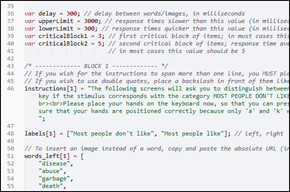Current version: 1.4 ()
This script will allow you to set up an IAT task for testing implicit attitudes. This script is meant to work in conjunction with Bill’s survey script or my survey form template.
There are two ways to set up an IAT task for your study:

The easy way: Go to this page and fill in the textboxes

The fun way: Follow the instructions on this page and edit the code to your satisfaction
In addition, if you want more detailed information on any of the features, you may view the complete instructions.
Disclaimer: Javascript has a couple fundamental limitations with how it runs timed events. First, its internal clock can be off by about +/-15ms in some browsers (info). In addition, the processing speed of computers may cause events to take longer than they should (i.e. a 20ms prime may take 25ms instead). I have created a list of a few methods to compensate for these problems.
Features
The features of this IAT script include the following:
- Can insert words and images to be displayed
- Outlying response times can be trimmed automatically using upper and lower limits (in ms)
- Instructions and labels can be set individually for each block
- Simple, clean output with the important variables for each participant (see below)
If you need more complex features than what is offered here, check out the RT script, which offers more flexibility.
Output
When participants complete the task, the output will consist of nine numbers for each one:
- The average response time of the first critical block (Block 3)
- The standard deviation of correct responses in the first critical block
- The error rate (proportion incorrect) of the first critical block
- The average response time of the second critical block (Block 5)
- The standard deviation of correct responses in the second critical block
- The error rate (proportion incorrect) of the second critical block
- The difference between the average response times of the two critical blocks: (Block 3 − Block 5)
- The standard deviation of response times for all correct responses in the two critical blocks
- The average error rate of the two critical blocks: (proportion incorrect for Block 3 + proportion incorrect for Block 5) / 2
Note: For those who wish to follow the scoring algorithm used by Greenwald, Nosek, & Banaji (2003), I’ve set up an Excel template to convert my script’s output into an approximation of their approach. However, this template cannot get back reaction times that have been truncated with upper or lower limits (outliers). Nevertheless, it should provide a pretty good approximation. If you wish to follow the method of Greenwald et al. to the letter, I recommend using my RT script, which provides the raw reaction time data so you have complete control over outliers, scoring algorithms, etc.
